Effect of Glass Fiber-Reinforced Plastic Waste on the Mechanical Properties of Concrete and Evaluation of Its Feasibility for Reuse in Concrete Applications
Abstract
:1. Introduction
2. Materials and Methods
2.1. Material Origin and Components
2.2. Concrete Mix Proportions
2.3. Specimen Preparation and Testing Procedures
3. Results
3.1. Test on the rGFRP
3.2. Test on the Concrete
3.2.1. Effect of rGFRP on the Workability of Fresh Concrete
3.2.2. Effect of rGFRP on the Compressive Strength of Concrete
3.2.3. Effect of rGFRP on the Splitting Tensile Strength of Concrete
3.2.4. Effect of rGFRP on the Microstructure of Concrete
3.2.5. Effect of rGFRP on the Density of Concrete
4. Optimization of Reusing rGFRP in Concrete
4.1. Selection of Recycling Technology
4.2. Characterization of rGFRP
4.3. Optimization of Mix Proportions
4.4. Evaluation of Concrete Quality
5. Conclusions
Author Contributions
Funding
Institutional Review Board Statement
Informed Consent Statement
Data Availability Statement
Conflicts of Interest
References
- Berardi, V.P.; Perrella, M.; Feo, L.; Cricri, G. Creep behavior of GFRP laminates and their phases: Experimental investigation and analytical modeling. Compos. Part B-Eng. 2017, 122, 136–144. [Google Scholar]
- Rafiee, R.; Ghorbanhosseini, A. Developing a micro-macromechanical approach for evaluating long-term creep in composite cylinders. Thin-Walled Struct. 2020, 151, 106714. [Google Scholar] [CrossRef]
- Zhu, Y.X.; Chen, Z.Y.; Jiang, Y.B.; Zhao, T.; Li, Y.; Chen, J.Z.; Fang, D.N. Design, fabrication and stiffness analysis of a novel GFRP sandwiched pipe with stiffened core. Thin-Walled Struct. 2020, 156, 106982. [Google Scholar] [CrossRef]
- Farinha, C.B.; de Brito, J.; Veiga, R. Assessment of glass fibre reinforced polymer waste reuse as filler in mortars. J. Clean. Prod. 2019, 210, 1579–1594. [Google Scholar] [CrossRef]
- Imjai, T.; Garcia, R.; Guadagnini, M.; Pilakoutas, K. Strength Degradation in Curved Fiber-reinforced Polymer (FRP) Bars Used as Concrete Reinforcement. Polymers 2020, 12, 1653. [Google Scholar] [CrossRef]
- Imjai, T.; Guadagnini, M.; Garcia, R.; Pilakoutas, K. A practical method for determining shear crack induced deformation in FRP RC beams. Eng. Struct. 2016, 126, 353–364. [Google Scholar] [CrossRef]
- Tittarelli, F.; Shah, S.P. Effect of low dosages of waste GRP dust on fresh and hardened properties of mortars: Part 1. Constr. Build. Mater. 2013, 47, 1532–1538. [Google Scholar] [CrossRef]
- Zabihi, O.; Ahmadi, M.; Liu, C.; Mahmoodi, R.; Li, Q.; Ferdowsi, M.; Naebe, M. A Sustainable Approach to the Low-Cost Recycling of Waste Glass Fibres Composites towards Circular Economy. Sustainability 2020, 12, 641. [Google Scholar] [CrossRef]
- Castro, A.C.M.; Carvalho, J.P.; Ribeiro, M.C.S.; Meixedo, J.P.; Silva, F.J.G.; Fiuza, A.; Dinis, M.L. An integrated recycling approach for GFRP pultrusion wastes: Recycling and reuse assessment into new composite materials using Fuzzy Boolean Nets. J. Clean. Prod. 2014, 66, 420–430. [Google Scholar] [CrossRef]
- Conroy, A.; Halliwell, S.; Reynolds, T. Composite recycling in the construction industry. Compos. Part A Appl. Sci. Manuf. 2006, 37, 1216–1222. [Google Scholar] [CrossRef]
- Åkesson, D.; Foltynowicz, Z.; Christéen, J.; Skrifvars, M. Microwave pyrolysis as a method of recycling glass fibre from used blades of wind turbines. J. Reinf. Plast. Compos. 2012, 31, 1136–1142. [Google Scholar] [CrossRef]
- Oliveux, G.; Dandy, L.O.; Leeke, G.A. Current status of recycling of fibre reinforced polymers: Review of technologies, reuse and resulting properties. Prog. Mater. Sci. 2015, 72, 61–99. [Google Scholar] [CrossRef]
- Job, S. Recycling composites commercially. Reinf. Plast. 2014, 58, 32–38. [Google Scholar] [CrossRef]
- Lin, J.; Guo, Z.X.; Hong, B.; Xu, J.Q.; Fan, Z.P.; Lu, G.Y.; Wang, D.W.; Oeser, M. Using recycled waste glass fiber reinforced polymer (GFRP) as filler to improve the performance of asphalt mastics. J. Clean. Prod. 2022, 336, 130357. [Google Scholar] [CrossRef]
- Shima, H.; Takahashi, H.; Mizuguchi, J. Recovery of Glass Fibers from Fiber Reinforced Plastics. Mater. Trans. 2011, 52, 1327–1329. [Google Scholar] [CrossRef]
- Guido, G.; Tomohito, K.; Tomoyuki, M.; Toshiaki, Y. Recovery of glass fibers from glass fiber reinforced plastics by pyrolysis. J. Mater. Cycles Waste Manag. 2013, 15, 122–128. [Google Scholar]
- Meira Castro, A.C.; Ribeiro, M.C.S.; Santos, J.; Meixedo, J.P.; Silva, F.J.G.; Fiúza, A.; Dinis, M.L.; Alvim, M.R. Sustainable waste recycling solution for the glass fibre reinforced polymer composite materials industry. Constr. Build. Mater. 2013, 45, 87–94. [Google Scholar] [CrossRef]
- Krauklis, A.; Karl, C.; Gagani, A.; Jørgensen, J. Composite Material Recycling Technology—State-of-the-Art and Sustainable Development for the 2020s. J. Compos. Sci. 2021, 5, 28. [Google Scholar] [CrossRef]
- Pickering, S.J. Recycling technologies for thermoset composite materials—Current status. Compos. Part A Appl. Sci. Manuf. 2006, 37, 1206–1215. [Google Scholar] [CrossRef]
- Akbar, A.; Liew, K.M. Assessing recycling potential of carbon fiber reinforced plastic waste in production of eco-efficient cement-based materials. J. Clean. Prod. 2020, 274, 123001. [Google Scholar] [CrossRef]
- Ahmed, S.; Ali, M. Use of agriculture waste as short discrete fibers and glass-fiber-reinforced-polymer rebars in concrete walls for enhancing impact resistance. J. Clean. Prod. 2020, 268, 122211. [Google Scholar] [CrossRef]
- Pietrzak, A.; Ulewicz, M. Influence of Post-Consumer Waste Thermoplastic Elastomers Obtained from Used Car Floor Mats on Concrete Properties. Materials 2023, 16, 2231. [Google Scholar] [CrossRef] [PubMed]
- Ulewicz, M. Recycled Materials for Concrete and Other Composites. Materials 2021, 14, 2279. [Google Scholar]
- Hendriks, C.F.; Janssen, G.M.T. Use of recycled materials in constructions. Mater. Struct. 2003, 36, 604–608. [Google Scholar]
- Zhou, B.; Zhang, M.; Wang, L.; Ma, G. Experimental study on mechanical property and microstructure of cement mortar reinforced with elaborately recycled GFRP fiber. Cem. Concr. Compos. 2021, 117, 103908. [Google Scholar] [CrossRef]
- Sebaibi, N.; Benzerzour, M.; Abriak, N.E.; Binetruy, C. Mechanical properties of concrete-reinforced fibres and powders with crushed thermoset composites: The influence of fibre/matrix interaction. Constr. Build. Mater. 2012, 29, 332–338. [Google Scholar] [CrossRef]
- Li, Y.-F.; Hsu, Y.-W.; Syu, J.-Y.; Chen, B.-Y.; Song, B. Study on the Utilization of Waste Thermoset Glass Fiber-Reinforced Polymer in Normal Strength Concrete and Controlled Low Strength Material. Materials 2023, 16, 3552. [Google Scholar] [CrossRef] [PubMed]
- Asokan, P.; Osmani, M.; Price, A.D.F. Improvement of the mechanical properties of glass fibre reinforced plastic waste powder filled concrete. Constr. Build. Mater. 2010, 24, 448–460. [Google Scholar] [CrossRef]
- Correia, J.R.; Almeida, N.M.; Figueira, J.R. Recycling of FRP composites: Reusing fine GFRP waste in concrete mixtures. J. Clean. Prod. 2011, 19, 1745–1753. [Google Scholar]
- García, D.; Vegas, I.; Cacho, I. Mechanical recycling of GFRP waste as short-fiber reinforcements in microconcrete. Constr. Build. Mater. 2014, 64, 293–300. [Google Scholar] [CrossRef]
- Tittarelli, F.; Kawashima, S.; Tregger, N.; Moriconi, G.; Shah, S.P. Effect of GRP by-product addition on plastic and hardened properties of cement mortars. In Proceedings of the Second International Conference on Sustainable Construction Materials and Technologies, Ancona, Italy, 28–30 June 2010; pp. 28–30. [Google Scholar]
- Dehghan, A.; Peterson, K.; Shvarzman, A. Recycled Glass Fiber Reinforced Polymer Additions to Portland Cement Concrete. Constr. Build. Mater. 2017, 146, 238–250. [Google Scholar] [CrossRef]
- GB/T 14685-2022; SAC (Standardization Administration of the People’s Republic of China). Pebble and Crushed Stone for Construction. Standards Press of China: Beijing, China, 2022.
- GB 50164-2011; Ministry of Housing and Urban-Rural Development of the People’s Republic of China. Standard for Quality Control of Concrete. China Architecture & Building Press: Beijing, China, 2011.
- GB/T 50080-2016; Ministry of Housing and Urban-Rural Development of the People’s Republic of China. Standard for Test Method of Perforcemance on Ordinary Fresh Concrete. China Architecture & Building Press: Beijing, China, 2016.
- GB/T 50081-2019; Ministry of Housing and Urban-Rural Development of the People’s Republic of China. Standard for Test Methods of Concrete Physical and Mechanical Properties. China Architecture & Building Press: Beijing, China, 2019.
- BS EN 12390-7:2009; British Standards Institution. Testing Hardened Concrete. Part 7. Density of Hardened Concrete. British Standards Institution: London, UK, 2009.
- Fu, B.; Liu, K.C.; Chen, J.F.; Teng, J.G. Concrete reinforced with macro fibres recycled from waste GFRP. Constr. Build. Mater. 2021, 310, 125063. [Google Scholar] [CrossRef]
- Alberti, M.G.; Enfedaque, A.; Galvez, J.C. The effect of fibres in the rheology of self-compacting concrete. Constr. Build. Mater. 2019, 219, 144–153. [Google Scholar] [CrossRef]
- Kazmi, S.M.S.; Munir, M.J.; Wu, Y.F.; Patnaikuni, I. Effect of macro-synthetic fibers on the fracture energy and mechanical behavior of recycled aggregate concrete. Constr. Build. Mater. 2018, 189, 857–868. [Google Scholar] [CrossRef]
- Yang, Q.; Xian, G.; Karbhari, V.M. Hygrothermal ageing of an epoxy adhesive used in FRP strengthening of concrete. J. Appl. Polym. Sci. 2008, 107, 2607–2617. [Google Scholar] [CrossRef]
- Yazdanbakhsh, A.; Bank, L.C. A Critical Review of Research on Reuse of Mechanically Recycled FRP Production and End-of-Life Waste for Construction. Polymers 2014, 6, 1810–1826. [Google Scholar] [CrossRef]
- Yazdanhakhsh, A.; Bank, L.C.; Chen, C. Use of recycled FRP reinforcing bar in concrete as coarse aggregate and its impact on the mechanical properties of concrete. Constr. Build. Mater. 2016, 121, 278–284. [Google Scholar] [CrossRef]
- Mastali, M.; Abdollahnejad, Z.; Dalvand, A.; Sattarifard, A.; Illikainen, M. 19-Comparative effects of using recycled CFRP and GFRP fibers on fresh- and hardened-state properties of self-compacting concretes: A review. New Mater. Civ. Eng. 2020, 643–655. [Google Scholar] [CrossRef]
- Lee, H.-S.; Lim, S.-M.; Wang, X.-Y. Optimal Mixture Design of Low-CO2 High-Volume Slag Concrete Considering Climate Change and CO2 Uptake. Int. J. Concr. Struct. Mater. 2019, 13, 56. [Google Scholar]
- Ziolkowski, P.; Niedostatkiewicz, M.; Kang, S.-B. Model-Based Adaptive Machine Learning Approach in Concrete Mix Design. Materials 2021, 14, 1661. [Google Scholar] [CrossRef]
- Ziolkowski, P.; Niedostatkiewicz, M. Machine Learning Techniques in Concrete Mix Design. Materials 2019, 12, 1256. [Google Scholar] [CrossRef]
- Song, Y.; Wang, X.; Li, H.; He, Y.; Zhang, Z.; Huang, J. Mixture Optimization of Cementitious Materials Using Machine Learning and Metaheuristic Algorithms: State of the Art and Future Prospects. Materials 2022, 15, 7830. [Google Scholar] [CrossRef] [PubMed]
- Chou, J.-S.; Pham, A.-D. Enhanced artificial intelligence for ensemble approach to predicting high performance concrete compressive strength. Constr. Build. Mater. 2013, 49, 554–563. [Google Scholar] [CrossRef]
- Mashhadban, H.; Kutanaei, S.S.; Sayarinejad, M.A. Prediction and modeling of mechanical properties in fiber reinforced self-compacting concrete using particle swarm optimization algorithm and artificial neural network. Constr. Build. Mater. 2016, 119, 277–287. [Google Scholar] [CrossRef]
- Rosa, A.C.; Hammad, A.W.A.; Boer, D.; Haddad, A. Use of operational research techniques for concrete mix design: A systematic review. Heliyon 2023, 9, e15362. [Google Scholar] [CrossRef]
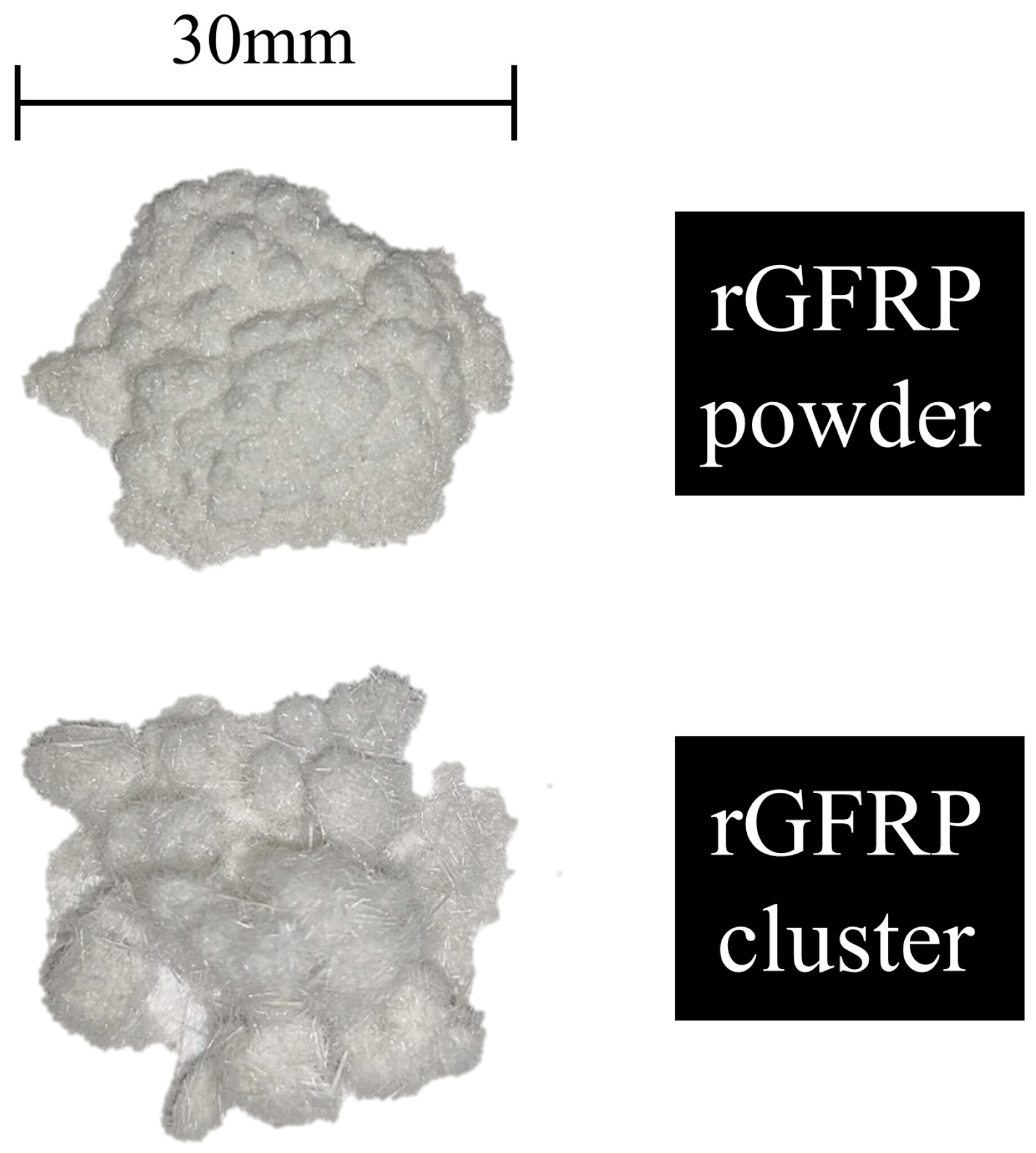


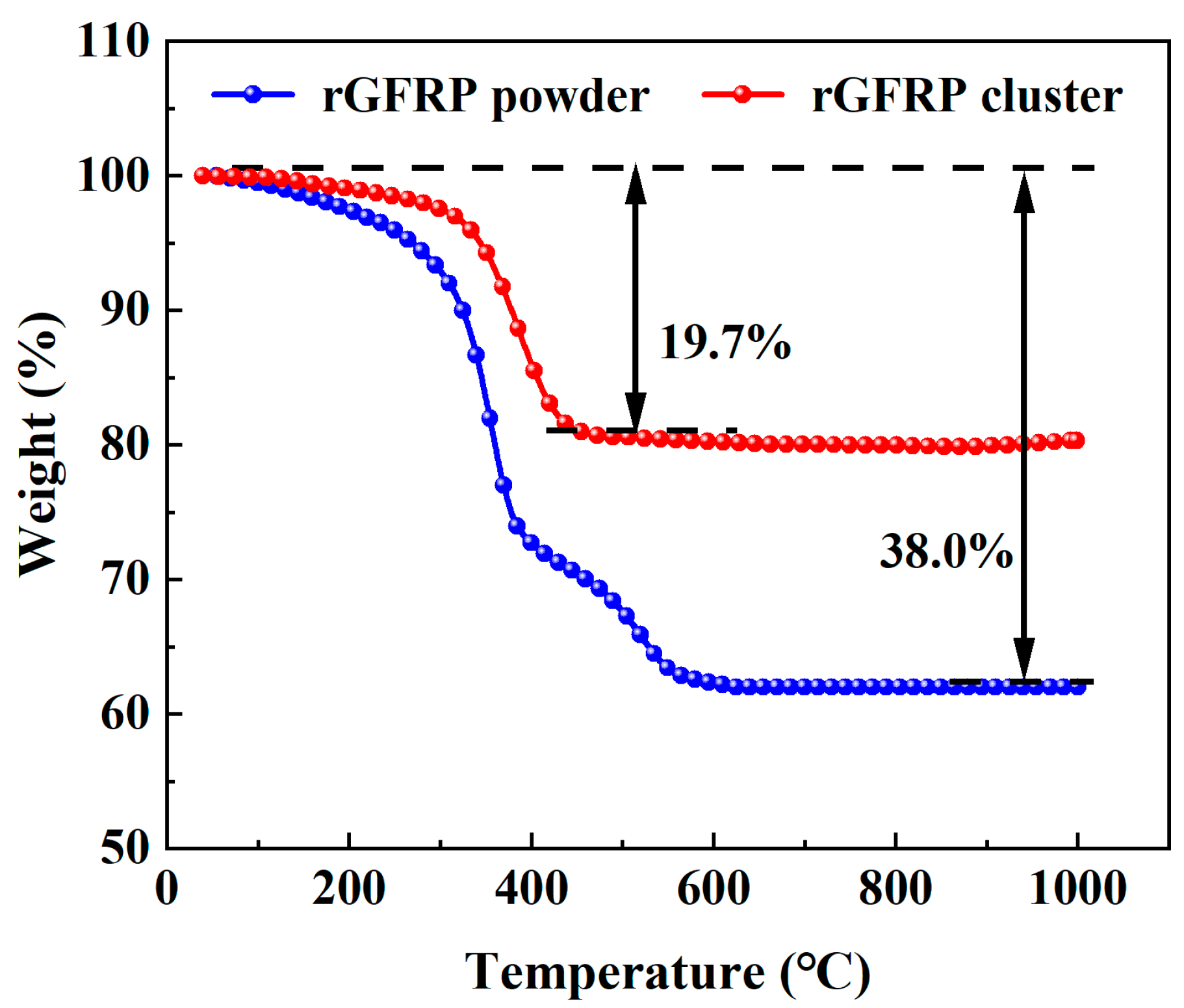

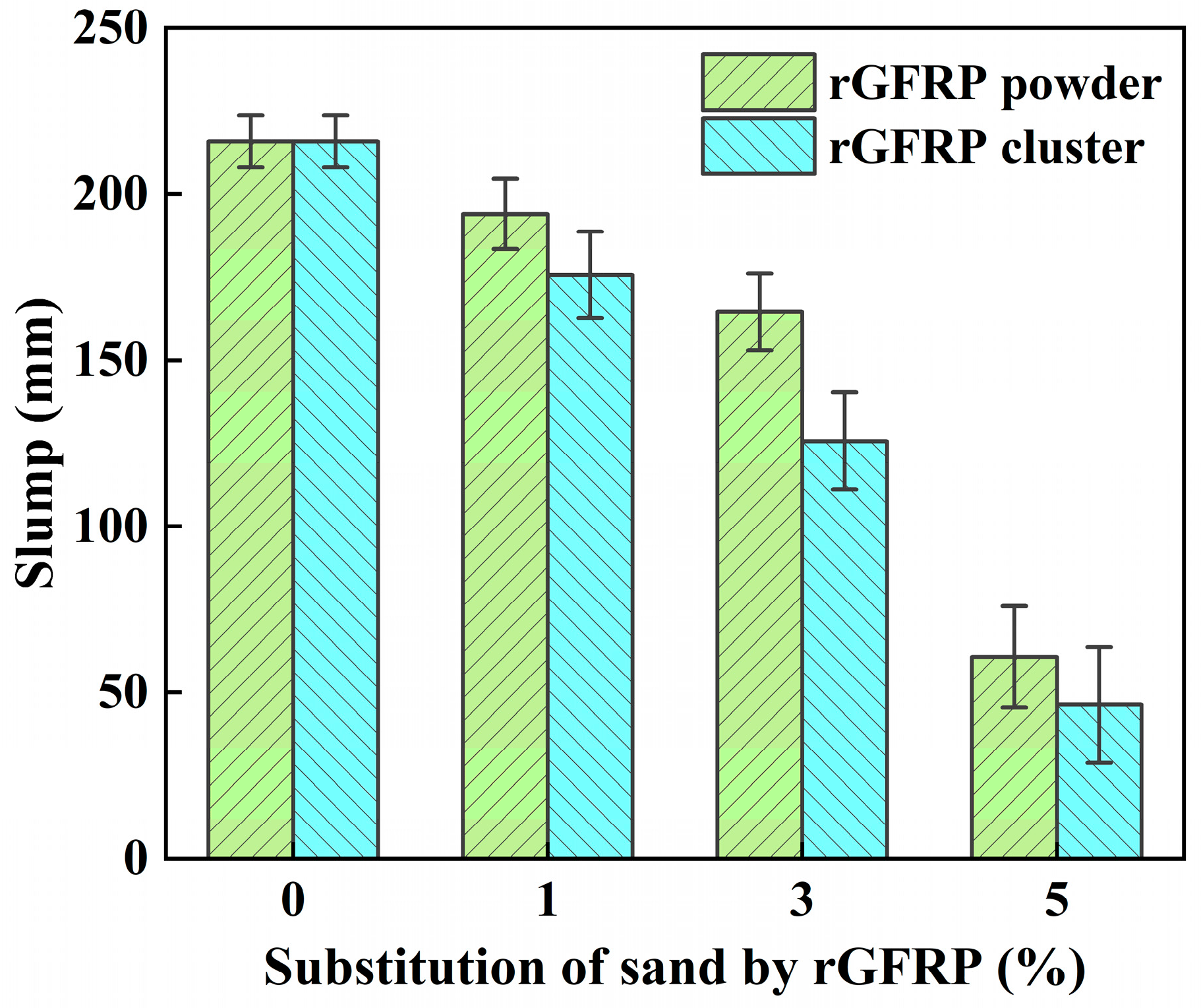

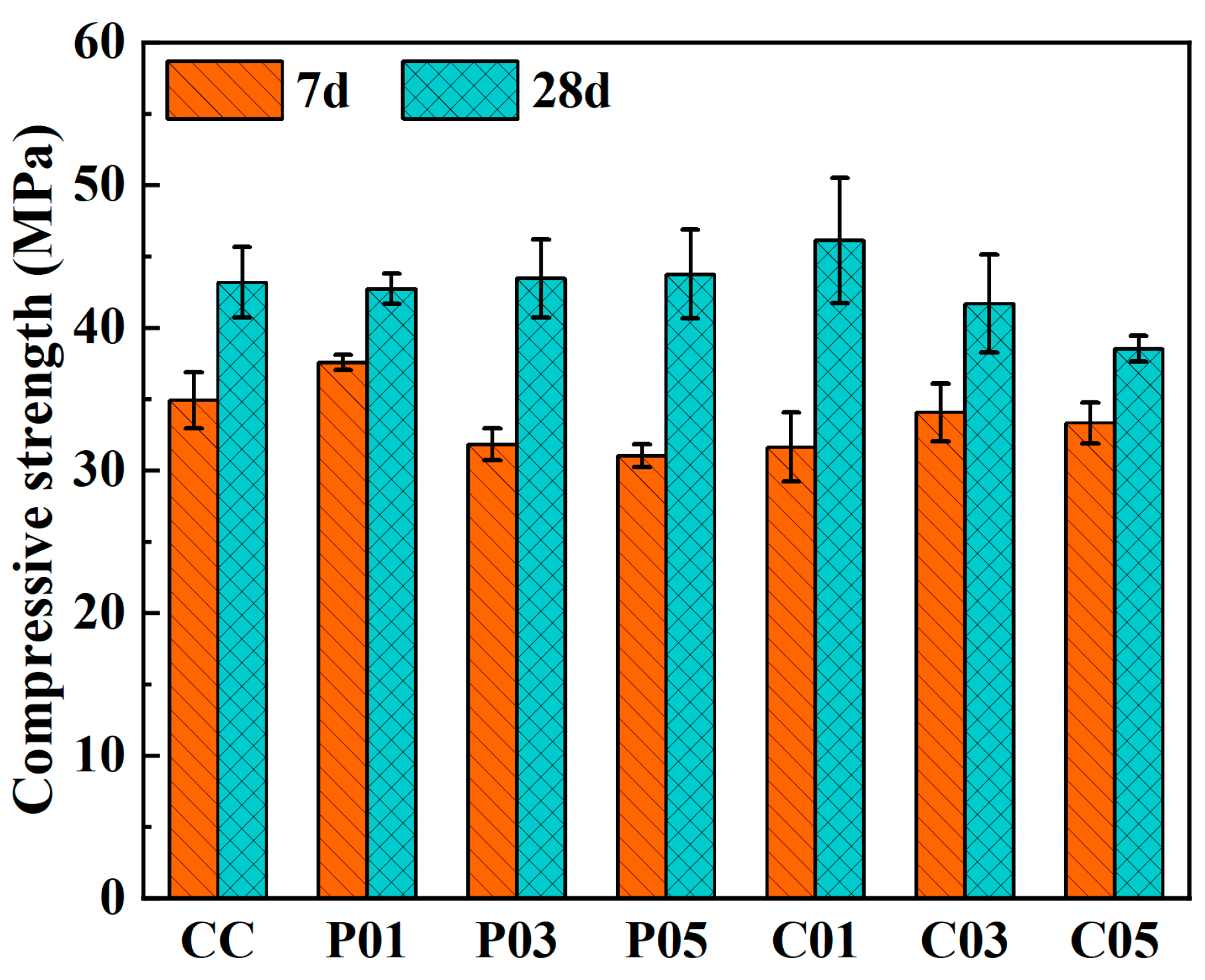
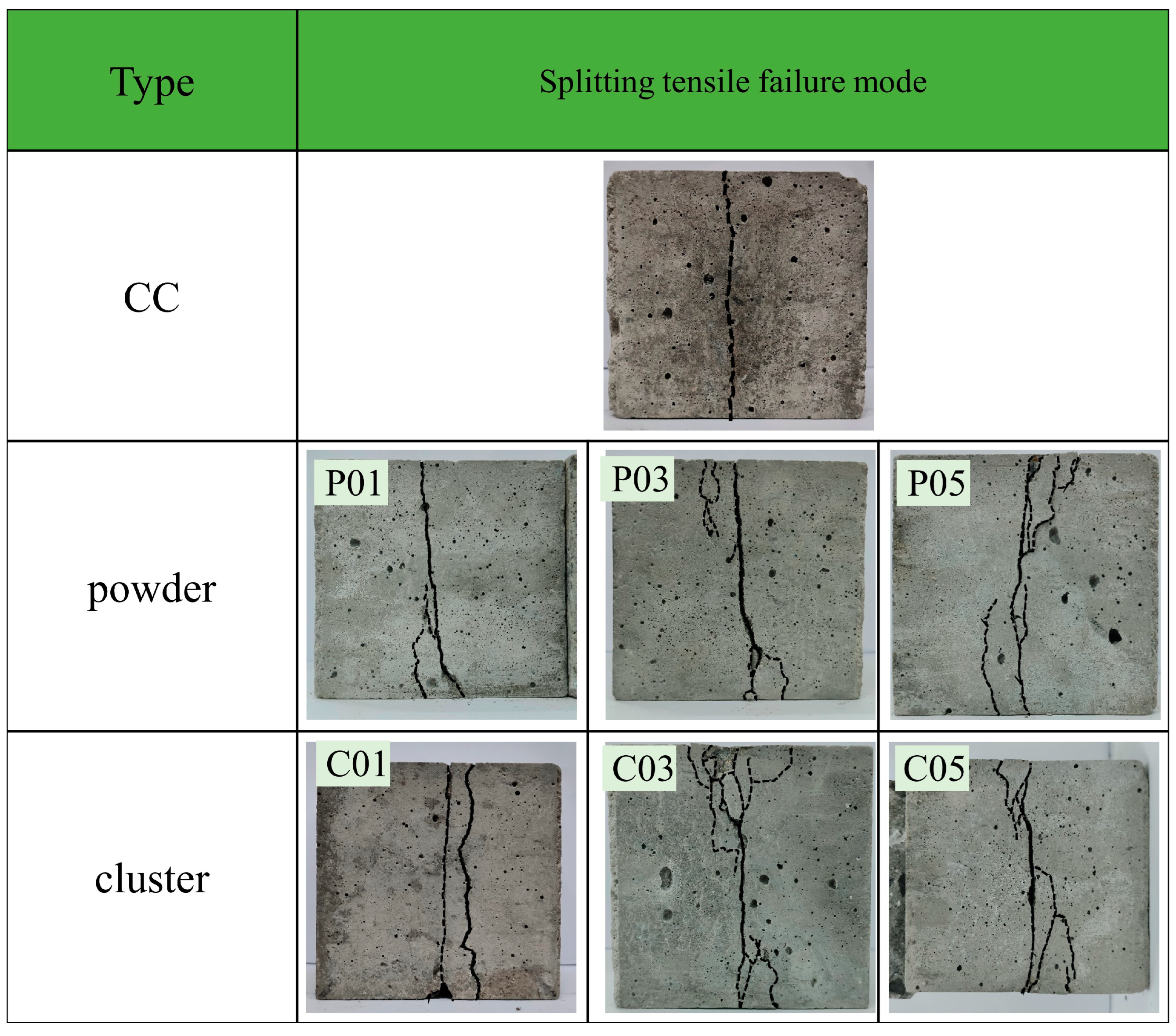

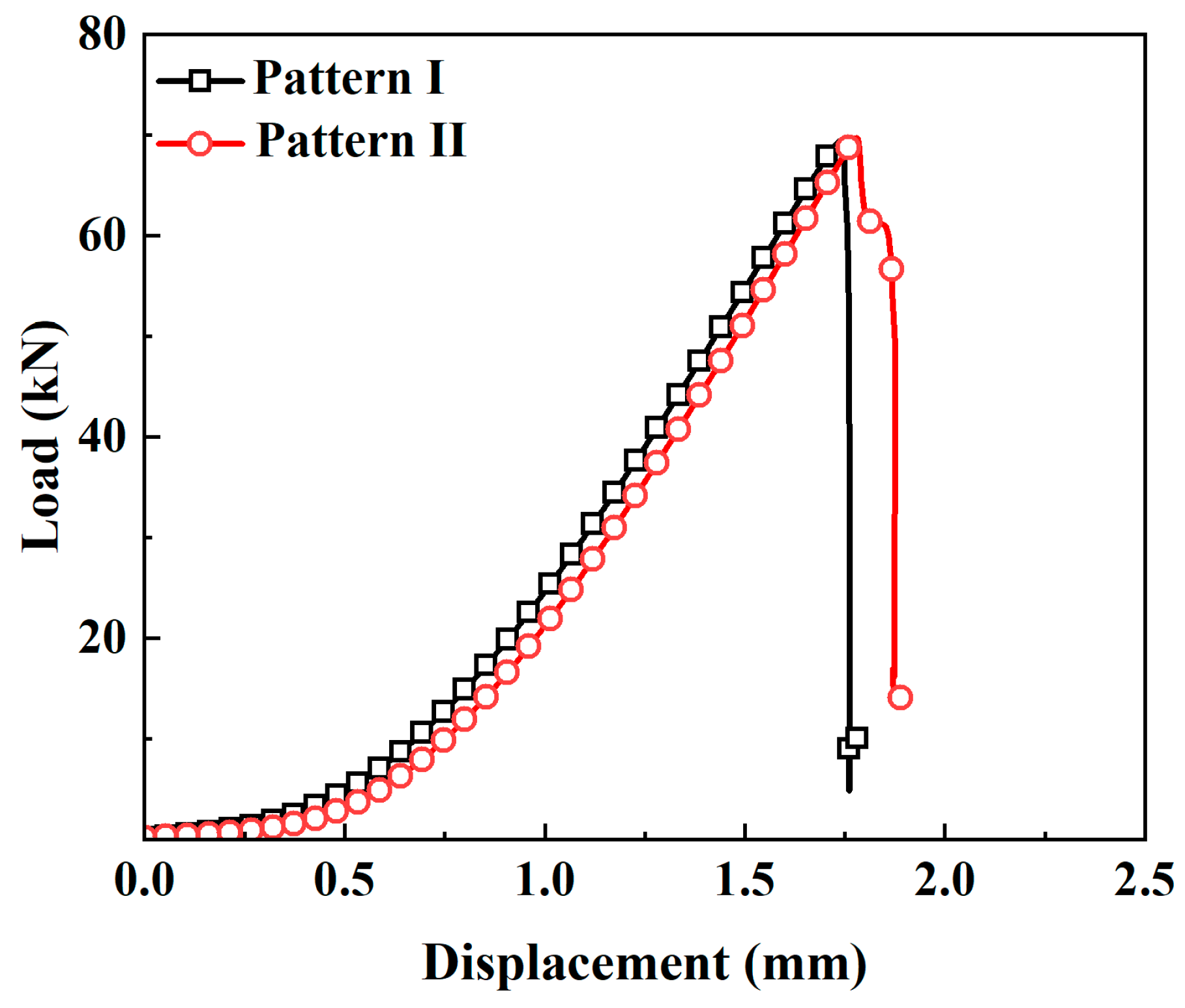
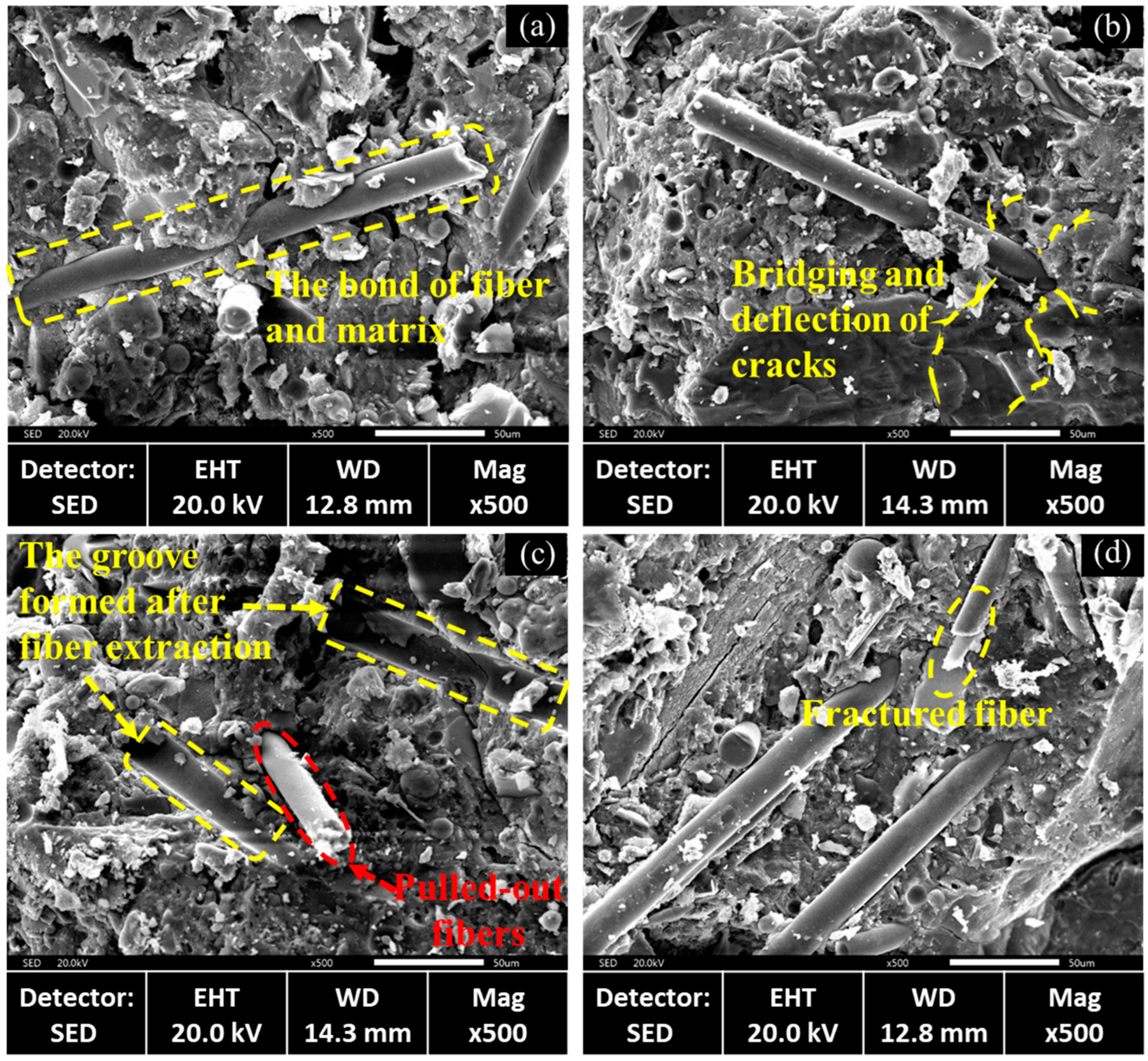
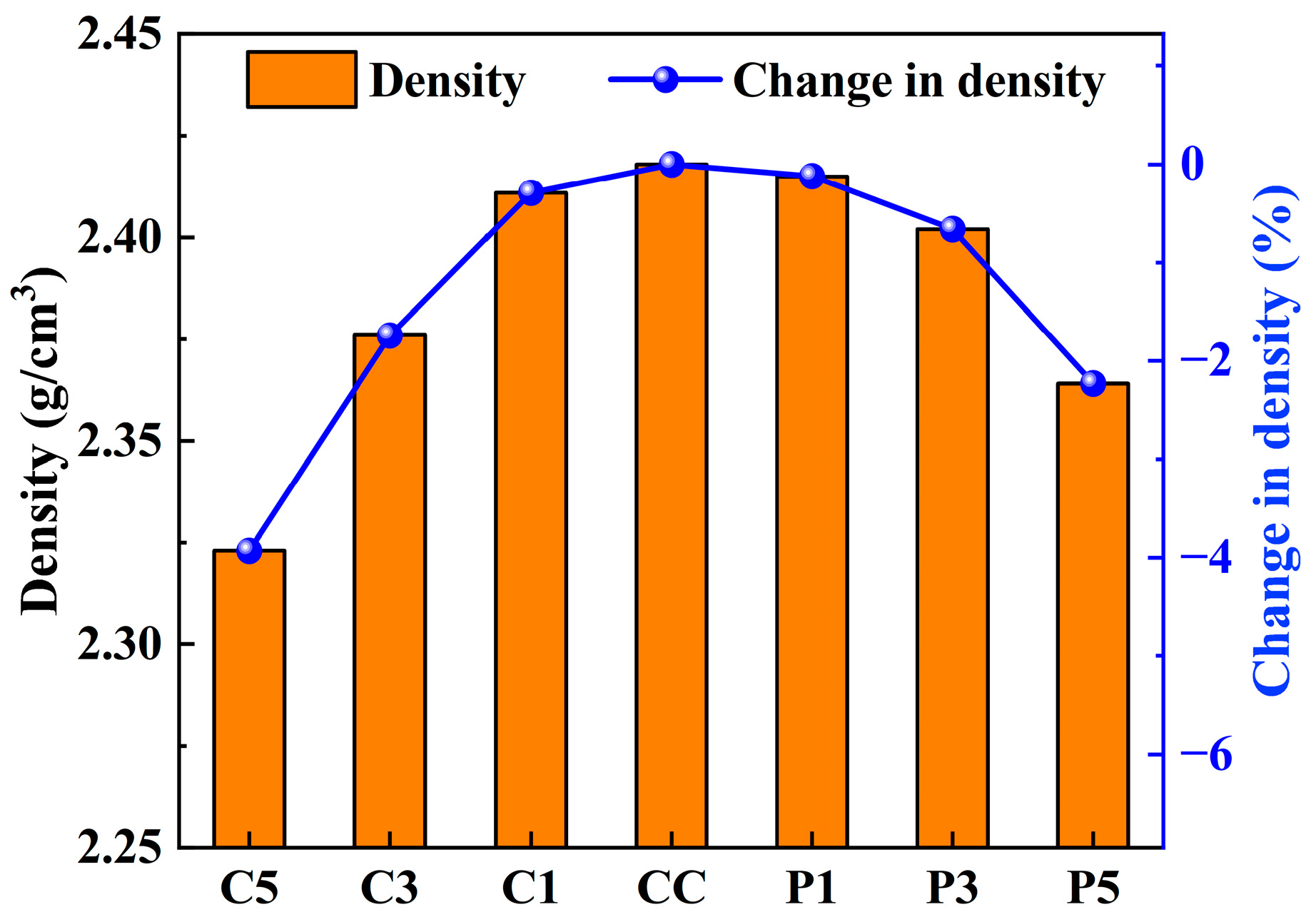

| Components | Na2O | MgO | Al2O3 | SiO2 | P2O5 | SO3 | K2O | CaO | Fe2O3 | LOI |
|---|---|---|---|---|---|---|---|---|---|---|
| Cement | 0.2 | 2.1 | 5.3 | 19.9 | 0.1 | 2.4 | 0.8 | 61.4 | 2.8 | 4.4 |
| Fly ash | 0.9 | 1.0 | 31.1 | 54.0 | 0.7 | 0.7 | 2.0 | 4.0 | 4.2 | - |
| Mineral powder | - | 6.0 | 17.7 | 34.5 | - | 1.6 | - | 34.0 | 1.0 | 0.8 |
| rGFRP | 0.4 | 1.9 | 10.0 | 40.4 | 0.1 | 0.1 | 0.4 | 19.9 | 0.8 | 25.4 |
| Concrete Mixture | rGFRP Type | CA | FA | Cement | Superplasticizer | Fly Ash | Mineral Powder | Water | rGFRP |
|---|---|---|---|---|---|---|---|---|---|
| CC | -- | 1011 | 732 | 333 | 7.1 | 71.4 | 71.4 | 182 | 0 |
| P01 | powder | 1011 | 725 | 333 | 7.1 | 71.4 | 71.4 | 182 | 7 |
| P03 | powder | 1011 | 710 | 333 | 7.1 | 71.4 | 71.4 | 182 | 22 |
| P05 | powder | 1011 | 695 | 333 | 7.1 | 71.4 | 71.4 | 182 | 37 |
| C01 | cluster | 1011 | 725 | 333 | 7.1 | 71.4 | 71.4 | 182 | 7 |
| C03 | cluster | 1011 | 710 | 333 | 7.1 | 71.4 | 71.4 | 182 | 22 |
| C05 | cluster | 1011 | 695 | 333 | 7.1 | 71.4 | 71.4 | 182 | 37 |
| Test | Specification | Specimen Size | |
|---|---|---|---|
| Fresh state | Slump | GB/T 50080 [35] | -- |
| Hardened state | Compressive strength | GB/T 50081 [36] | 100 × 100 × 100 mm3 |
| Tensile splitting strength | GB/T 50081 [36] | 100 × 100 × 100 mm3 | |
| Density | BS EN 12390-7 [37] | 100 × 100 × 100 mm3 | |
| Concrete Mixture | Test No. | |||||||
|---|---|---|---|---|---|---|---|---|
| 1 | 2 | 3 | 4 | 5 | 6 | Mean | SD | |
| CC | 220 | 229 | 210 | 214 | 215 | 207 | 216 | 7.83 |
| P01 | 200 | 210 | 196 | 182 | 183 | 193 | 194 | 10.60 |
| P03 | 170 | 159 | 150 | 173 | 180 | 155 | 165 | 11.60 |
| P05 | 68 | 51 | 80 | 54 | 39 | 72 | 61 | 15.25 |
| C01 | 180 | 166 | 156 | 176 | 193 | 183 | 176 | 13.06 |
| C03 | 114 | 107 | 143 | 142 | 126 | 122 | 126 | 14.60 |
| C05 | 28 | 43 | 36 | 69 | 35 | 67 | 46 | 17.45 |
| Concrete Mixture | rGFRP Content (%) | 7-Day Compressive Strength (MPa) | 28-Day Compressive Strength (MPa) | ||||||||
|---|---|---|---|---|---|---|---|---|---|---|---|
| Specimen No. | Mean | SD | Specimen No. | Mean | SD | ||||||
| 1 | 2 | 3 | 1 | 2 | 3 | ||||||
| CC | 0 | 33.45 | 34.15 | 37.17 | 34.92 | 1.97 | 45.17 | 40.43 | 43.92 | 43.17 | 2.45 |
| P01 | 1 | 38.15 | 37.37 | 37.15 | 37.55 | 0.52 | 43.63 | 41.58 | 42.95 | 42.72 | 1.04 |
| P03 | 3 | 32.67 | 32.23 | 30.55 | 31.82 | 1.12 | 45.40 | 44.61 | 40.33 | 43.45 | 2.73 |
| P05 | 5 | 31.93 | 30.65 | 30.43 | 31.01 | 0.81 | 46.31 | 44.61 | 40.27 | 43.73 | 3.12 |
| C01 | 1 | 30.30 | 30.16 | 34.39 | 31.62 | 2.40 | 49.61 | 47.55 | 41.16 | 46.11 | 4.41 |
| C03 | 3 | 32.23 | 36.22 | 33.70 | 34.05 | 2.02 | 43.02 | 44.24 | 37.76 | 41.67 | 3.45 |
| C05 | 5 | 34.89 | 32.93 | 32.11 | 33.31 | 1.43 | 39.38 | 37.58 | 38.61 | 38.52 | 0.91 |
| Concrete Mixture | rGFRP Content (%) | 7-Day Splitting Tensile Strength (MPa) | 28-Day Splitting Tensile Strength (MPa) | ||||||||
|---|---|---|---|---|---|---|---|---|---|---|---|
| Specimen No. | Mean | SD | Specimen No. | Mean | SD | ||||||
| 1 | 2 | 3 | 1 | 2 | 3 | ||||||
| CC | 0 | 2.86 | 2.92 | 3.30 | 3.03 | 0.24 | 3.63 | 4.23 | 3.60 | 3.82 | 0.36 |
| P01 | 1 | 3.05 | 3.12 | 2.99 | 3.05 | 0.07 | 3.35 | 4.21 | 4.02 | 3.86 | 0.45 |
| P03 | 3 | 2.90 | 2.86 | 2.92 | 2.89 | 0.03 | 4.30 | 3.86 | 3.78 | 3.98 | 0.28 |
| P05 | 5 | 2.73 | 2.62 | 2.93 | 2.76 | 0.16 | 3.83 | 4.09 | 3.93 | 3.95 | 0.13 |
| C01 | 1 | 3.20 | 2.99 | 2.98 | 3.06 | 0.12 | 3.34 | 4.10 | 3.92 | 3.79 | 0.40 |
| C03 | 3 | 3.37 | 3.04 | 3.62 | 3.34 | 0.29 | 3.77 | 4.29 | 3.76 | 3.94 | 0.30 |
| C05 | 5 | 2.73 | 3.11 | 2.89 | 2.91 | 0.19 | 3.65 | 3.26 | 3.54 | 3.48 | 0.20 |
Disclaimer/Publisher’s Note: The statements, opinions and data contained in all publications are solely those of the individual author(s) and contributor(s) and not of MDPI and/or the editor(s). MDPI and/or the editor(s) disclaim responsibility for any injury to people or property resulting from any ideas, methods, instructions or products referred to in the content. |
© 2023 by the authors. Licensee MDPI, Basel, Switzerland. This article is an open access article distributed under the terms and conditions of the Creative Commons Attribution (CC BY) license (https://creativecommons.org/licenses/by/4.0/).
Share and Cite
Zhao, T.; Lv, Y.; Chen, J.; Song, P.; Sun, M.; Zhang, X.; Huang, L. Effect of Glass Fiber-Reinforced Plastic Waste on the Mechanical Properties of Concrete and Evaluation of Its Feasibility for Reuse in Concrete Applications. Materials 2023, 16, 6772. https://doi.org/10.3390/ma16206772
Zhao T, Lv Y, Chen J, Song P, Sun M, Zhang X, Huang L. Effect of Glass Fiber-Reinforced Plastic Waste on the Mechanical Properties of Concrete and Evaluation of Its Feasibility for Reuse in Concrete Applications. Materials. 2023; 16(20):6772. https://doi.org/10.3390/ma16206772
Chicago/Turabian StyleZhao, Tianhao, Yong Lv, Jianzhong Chen, Pengfei Song, Mingqing Sun, Xiaoyu Zhang, and Li Huang. 2023. "Effect of Glass Fiber-Reinforced Plastic Waste on the Mechanical Properties of Concrete and Evaluation of Its Feasibility for Reuse in Concrete Applications" Materials 16, no. 20: 6772. https://doi.org/10.3390/ma16206772
APA StyleZhao, T., Lv, Y., Chen, J., Song, P., Sun, M., Zhang, X., & Huang, L. (2023). Effect of Glass Fiber-Reinforced Plastic Waste on the Mechanical Properties of Concrete and Evaluation of Its Feasibility for Reuse in Concrete Applications. Materials, 16(20), 6772. https://doi.org/10.3390/ma16206772





